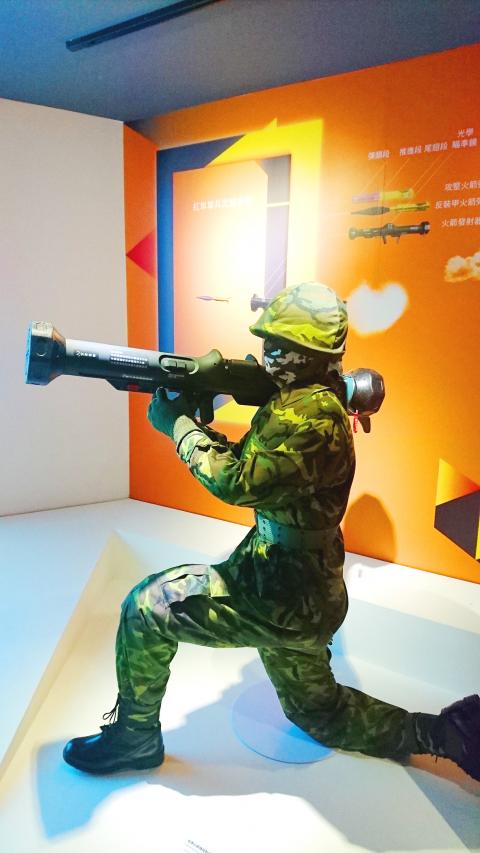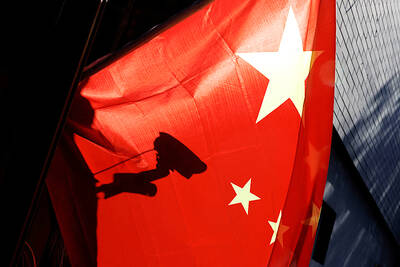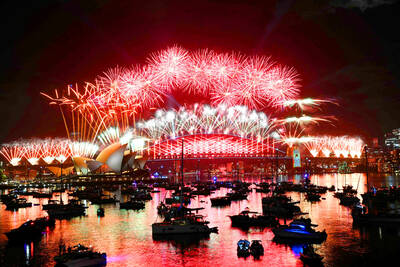Nearly 400 domestically produced Kestrel missiles have been deployed in Taipei to protect key government infrastructure in the event of attacks by China’s People’s Liberation Army, and more missiles would be purchased next year, the Military Police Command said in its annual budget report submitted to the Legislative Yuan yesterday.
The Kestrel missile launcher is a disposable, shoulder-launched, single-shot system that can fire a high-explosive anti-tank warhead or a high-explosive squash head.
The command deployed the first of them in the capital in October as part of a two-year program first announced last year.

Photo: Lo Tien-pin, Taipei Times
It has so far procured 397 missiles, 238 test missiles and five training simulators from the Chungshan Institute of Science and Technology, the command said.
The military has formed the Quick-Reaction Company at the 202nd Military Police Regional Command and garrisoned additional forces in the city, which would allow it to respond quickly in the event of a threat to the central government, the command said.
The missile systems cost NT$43.03 million (US$1.41 million), it said, adding that next year the command plans to purchase 48 more missiles, 40 test missiles and three training simulators, which would cost of NT$5.97 million.
With the lightweight launchers, which could be deployed in high-rises or transported in vehicles, military police can launch mobile counterattacks in urban combat and retake crucial governmental structures, it said.
The missiles could destroy armored vehicles as well as enemy morale, it said.
Its decision to purchase the missile systems was made after carefully considering the “threat posed by the enemy,” the command said.

A magnitude 7.0 earthquake struck off Yilan at 11:05pm yesterday, the Central Weather Administration (CWA) said. The epicenter was located at sea, about 32.3km east of Yilan County Hall, at a depth of 72.8km, CWA data showed There were no immediate reports of damage. The intensity of the quake, which gauges the actual effect of a seismic event, measured 4 in Yilan County area on Taiwan’s seven-tier intensity scale, the data showed. It measured 4 in other parts of eastern, northern and central Taiwan as well as Tainan, and 3 in Kaohsiung and Pingtung County, and 2 in Lienchiang and Penghu counties and 1

FOREIGN INTERFERENCE: Beijing would likely intensify public opinion warfare in next year’s local elections to prevent Lai from getting re-elected, the ‘Yomiuri Shimbun’ said Internal documents from a Chinese artificial intelligence (AI) company indicated that China has been using the technology to intervene in foreign elections, including propaganda targeting Taiwan’s local elections next year and presidential elections in 2028, a Japanese newspaper reported yesterday. The Institute of National Security of Vanderbilt University obtained nearly 400 pages of documents from GoLaxy, a company with ties to the Chinese government, and found evidence that it had apparently deployed sophisticated, AI-driven propaganda campaigns in Hong Kong and Taiwan to shape public opinion, the Yomiuri Shimbun reported. GoLaxy provides insights, situation analysis and public opinion-shaping technology by conducting network surveillance

Taiwan is gearing up to celebrate the New Year at events across the country, headlined by the annual countdown and Taipei 101 fireworks display at midnight. Many of the events are to be livesteamed online. See below for lineups and links: Taipei Taipei’s New Year’s Party 2026 is to begin at 7pm and run until 1am, with the theme “Sailing to the Future.” South Korean girl group KARA is headlining the concert at Taipei City Hall Plaza, with additional performances by Amber An (安心亞), Nick Chou (周湯豪), hip-hop trio Nine One One (玖壹壹), Bii (畢書盡), girl group Genblue (幻藍小熊) and more. The festivities are to

Auckland rang in 2026 with a downtown fireworks display launched from New Zealand’s tallest structure, Sky Tower, making it the first major city to greet the new year at a celebration dampened by rain, while crowds in Taipei braved the elements to watch Taipei 101’s display. South Pacific countries are the first to bid farewell to 2025. Clocks struck midnight in Auckland, with a population of 1.7 million, 18 hours before the famous ball was to drop in New York’s Times Square. The five-minute display involved 3,500 fireworks launched from the 240m Sky Tower. Smaller community events were canceled across New Zealand’s